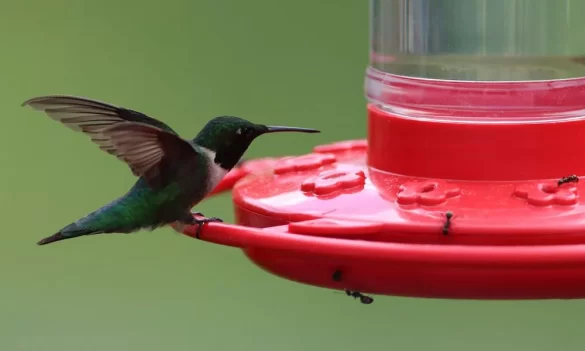Hummingbirds bring joy and energy to any garden. Their vibrant colors and swift movements make them a delight to watch. To attract these tiny birds, many people hang hummingbird feeders filled with sweet nectar. However, this nectar can also attract unwanted guests like bees. Bees are important pollinators, but their presence at feeders can deter hummingbirds and create a buzzing nuisance. Fortunately, there are effective and humane ways to keep bees away from your hummingbird feeders. Here are nine strategies to help you maintain a bee-free feeder.
9 Effective Ways to Keep Bees Away from Hummingbird Feeders
1. Choose Bee-Resistant Feeders
Selecting the right feeder is the first step in deterring bees. Opt for feeders designed with bee guards or those that minimize nectar leakage. Saucer-style feeders are particularly effective because they keep the nectar level below the feeding ports, making it harder for bees to access. Additionally, avoid feeders with yellow accents, as bees are attracted to the color yellow.
2. Relocate the Feeder to a Shady Spot
Bees prefer to forage in sunny areas. By placing your hummingbird feeder in a shaded location, you can make it less appealing to bees while still attracting hummingbirds. Shaded nectar also stays cooler, which slows fermentation and keeps the nectar fresh longer.
3. Keep the Feeder Clean and Leak-Free
Regular maintenance of your feeder is crucial. Bees are drawn to the scent of nectar, especially when it’s spilled or leaking. Ensure that your feeder is free from leaks and clean up any spills promptly. Regularly cleaning the feeder also prevents mold growth, which can be harmful to hummingbirds.
4. Use Nectar Guards
Nectar guards are small attachments that cover the feeding ports, allowing hummingbirds to access the nectar while blocking bees. These guards can be purchased separately or may come integrated into certain feeder designs. By installing nectar guards, you create a physical barrier that prevents bees from reaching the nectar.
5. Offer Alternative Food Sources for Bees
Creating a garden with bee-friendly flowers can divert bees away from your hummingbird feeders. Planting a variety of nectar-rich flowers such as zinnias, sunflowers, and bee balm provides bees with a natural food source. This strategy not only helps keep bees away from the feeders but also supports their role as pollinators in your garden.
See Also: 10 Best Ways to Keep Bees Away from Hummingbird Feeders
6. Move the Feeder Regularly
Bees are creatures of habit and will return to known food sources. By moving your hummingbird feeder periodically, even just a few feet, you can confuse and discourage bees. Hummingbirds, on the other hand, are more adaptable and will quickly locate the feeder’s new position.
7. Adjust the Sugar Concentration
Standard hummingbird nectar is made with a ratio of four parts water to one part sugar. Temporarily diluting the mixture to five parts water to one part sugar can make the nectar less appealing to bees while still satisfying hummingbirds. Once the bee activity decreases, you can return to the standard ratio.
8. Avoid Using Insecticides or Sticky Substances
It’s important to avoid using pesticides, insecticides, petroleum jelly, or other sticky substances to deter bees. These methods can harm both bees and hummingbirds and disrupt the natural balance of your garden. Instead, focus on natural and humane strategies to manage bee activity around your feeders.
9. Provide Fresh Water Sources
Bees require water for hydration and cooling their hives. By offering a shallow water source, such as a birdbath with pebbles for landing spots, you can attract bees away from your hummingbird feeders. Placing the water source in a sunny area will make it more appealing to bees, further diverting their attention from the feeders.
Implementing these strategies can help you maintain a hummingbird-friendly environment while minimizing bee interference. Remember, bees play a vital role in pollination and the health of our ecosystems. By providing alternative food sources and habitats for bees, you can enjoy the presence of hummingbirds without compromising the well-being of these essential pollinators.


 Facebook
Facebook  Instagram
Instagram  Youtube
Youtube 